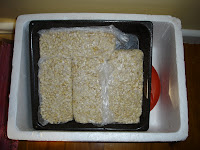
Although tempeh is now commonly available in Sydney and can be found in the refrigerated section of most well-stocked grocery stores. It is not as common as I thought among young Singaporeans here.I was surprised to find a number of young Singaporeans who are living away from home and probably cooking for themselves for the first time, have recently emailed to ask what is tempeh and how it is used. On close observation, tempeh looks like a square or rectangular piece of mouldy compressed bean cake Fear of the unknown can often make you stop dead in your tracks of using it in your cooking. For the uninitiated, tempeh is made from cooked and slightly fermented soybeans. A traditional Indonesian food originated from Java, it is made from soybeans, grains, and a mould culture that is fermented and pressed into a block or cake. This vegetarian food can be used as a substitution for meats. Furthermore, I have adapted a recipe to make homemade tempeh and saving half the price you would pay in the supermarkets by using a store bought fresh tempeh as a tempeh starter for the initial start up.
.
To make 1kg tempeh you need the following ingredients:
- 500 g whole dry soybeans
- 3 tbs vinegar
- 200 g of fresh tempeh
Soak the soybeans in 2 liter water overnight. Split the soaked soya beans by squeezing them with a kneading motion in a big basin or bowl. Stir gently causing the hulls to rise to the surface, then pour off water and hulls into a strainer. Add water and repeat until most hulls are removed. Put the hulled soyabeans in a large cooking pot and add water to cover the soybeans. Add 3 tablespoon vinegar and cook for 30 min. In the meanwhile, put the fresh tempeh in a blender and blend until fine like breadcrumbs. Drain off the water and dry the soybeans by continue heating them in the pot on medium heat for a few minutes and until the beans are dry. Allow the soybeans to cool down to below 35°C.


Sprinkle the soybeans with the blended tempeh. Mix with a clean spoon to distribute the blended tempeh evenly. It's very important to mix the blended tempeh very well, it reduces the risk for spoilage and the fermentation will be faster. Take 4 plastic resealable bags 18 x 18 cm and perforate them with holes at a distance of about 1 cm by a thick needle. This will allow the mould to breathe.
Divide the soybeans equally in the four bags and seal them. Press them flat, making sure that the total thickness of the beans is max 3 cm. Place the packed beans in a warm place to incubate for about 36- 48 hours during which the tempeh fermentation takes place. Then the plastic bags should be filled completely with a white mold and bind the soybeans into a cake form. The the entire piece of newly formed tempeh can be lifted out as a whole piece. Keep the fresh tempeh in the fridge to be used within a week or can be kept frozen until needed. Now you know how to make tempeh. Stay tuned on how to cook the tempeh.
phil, in this region (malaysia, indonesia and s'pore), they still use the leaves of the simpoh air to wrap the tempeh.
ReplyDeleteUnle Phil, gd morning..
ReplyDeleteDid u eat before Topioca with Wine dessert ? Wrapped with banana leaf ? I eat before when I was child.
Yen
Hi YG,
ReplyDeleteDo the hawkers in Singapore still use traditional wrappers such as simpoh air leaves, opeh leaves and banana leaves? Who can forget the fried kuehtiau wrapped with opeh leaves.
Cheers,
Phil
Hi Yen,
ReplyDeleteIs it tapeh? It is a sweet and mildly alcoholic dessert made from either tapioca or glutinous rice fermented with ragi (yeast). Itu ya?
CHeers
Phil
Hi, Ya, is that one, I miss that smell, do you how to make ? Can find Tapioca here ?
ReplyDeleteYen
Hi Yen,
ReplyDeleteYou can buy ubi kayu at the Sydney Market at Fleminton on the weekends. When I get the ubi I'll contact you to come and make the tapeh together.
Cheers.
phil, all three types of leaves are still in use. simpoh air has been traditionally used for wrapping tempeh. long ago, the rojak man and the chee cheong fun seller also used simpoh air leaves. for novelty reason, some hokkien mee sellers today use opeh leaves to serve the mee. banana leaves are still used for wrapping certain kuehs, and some nasi lemak are still packed with banana leaves. of course, if you eat at some of the restaurants along race course road, your food may be served on a banana leaf.
ReplyDelete